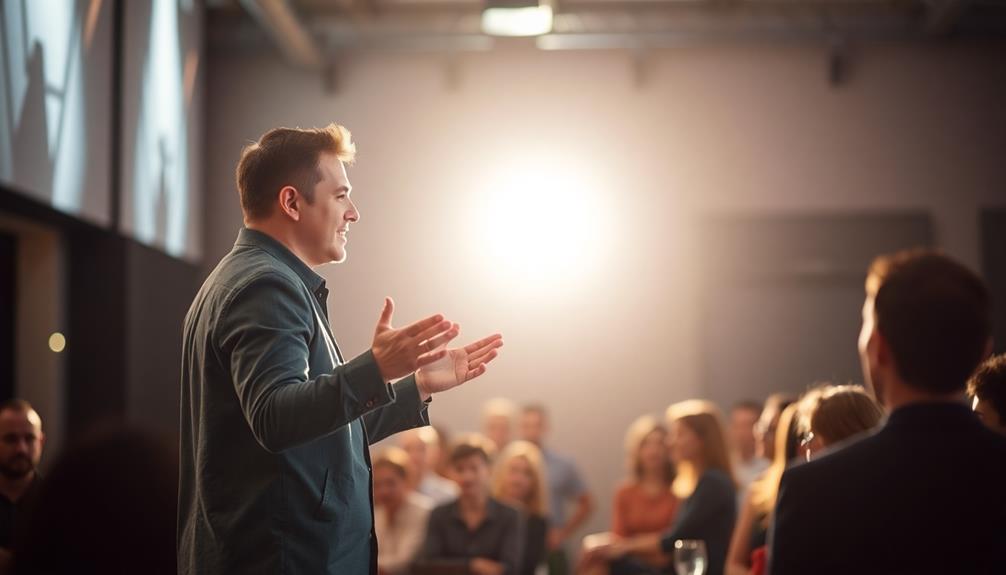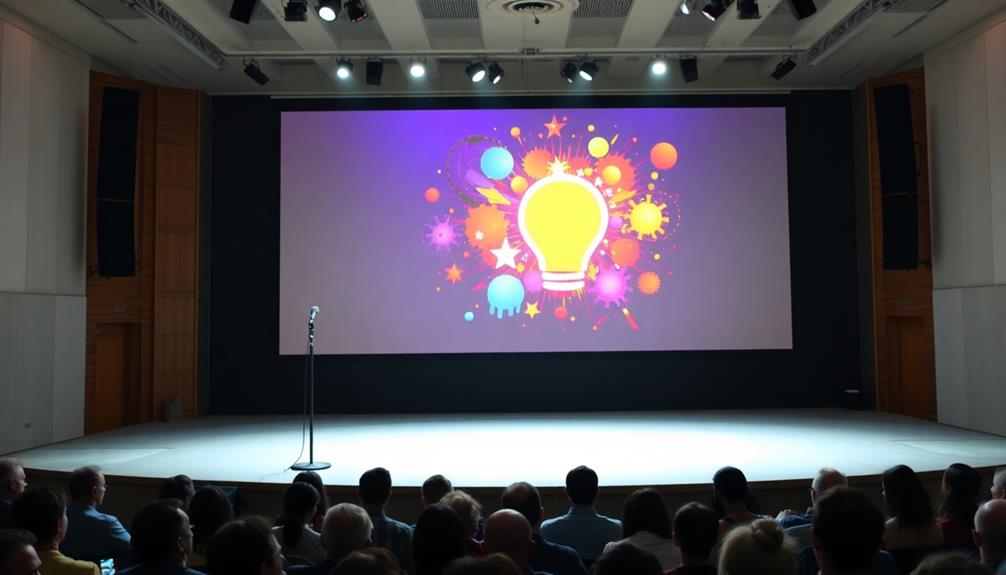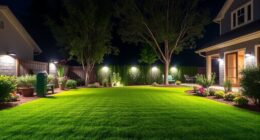To grab your audience's attention in the first 30 seconds of your TED Talk, start with a compelling hook—whether it's a surprising fact, an emotional story, or a thought-provoking question. Use engaging body language and maintain eye contact to build a connection. Make sure your opening sets the tone by incorporating vivid imagery or relatable anecdotes. Practice your delivery multiple times to boost confidence and refine your non-verbal cues. Remember, the goal is to create an emotional connection early on. Stick around to uncover more techniques that can transform your talk into a memorable experience.
Key Takeaways
- Start with a compelling hook, such as a surprising fact or emotional story, to immediately capture audience interest.
- Incorporate vivid imagery in your opening narrative to activate the audience's imagination and enhance engagement.
- Utilize open-ended questions or real-time polls to encourage audience participation and foster connection from the outset.
- Maintain eye contact and adopt an open posture to build trust and create an approachable atmosphere during your introduction.
- Practice your opening multiple times to boost confidence and ensure a smooth delivery that resonates with your audience.
Importance of First Impressions

The importance of first impressions in TED Talks can't be overstated. In those first 30 seconds, you have the power to capture your audience's attention or lose it completely. Studies show that their focus considerably drops after this brief window, making it essential for you to start strong.
Non-verbal communication plays a vital role here, accounting for 93% of interactions. Your facial expressions and body language set the tone for your entire presentation. A positive demeanor right from the beginning can enhance audience receptivity, while any signs of nervousness can quickly push them away.
You need to establish a strong emotional connection early on. This connection not only engages your audience but also boosts the retention of the ideas you present later. One effective method to achieve this is by starting with a compelling hook—a surprising fact, an emotional story, or a thought-provoking question.
Preparation and Practice Techniques

When preparing for your TED Talk, focus on crafting a strong opening—spend five times longer on those first 30 seconds than on any other part.
Engaging storytelling can captivate your audience right from the start, much like the techniques used in successful podcasts offer a platform for deeper connection.
Practicing your material multiple times not only boosts your confidence but also helps you connect better with your audience.
Prioritize Opening Preparation
Engaging your audience right from the start hinges on meticulous preparation. To capture their attention, you should prioritize opening preparation by spending five times longer crafting those first 30 seconds than any other section of your presentation. This effort guarantees a strong, enthralling opening that resonates.
Familiarity with your material will enhance your public speaking skills and reduce nervousness as you begin your talk. Additionally, understanding your target audience and their needs can further tailor your opening to their interests.
Consider recording your practice sessions. This technique allows you to analyze your facial feedback, helping you refine your expressions and overall style for a more compelling introduction. Writing out your presentation can also boost information retention and aid in structuring your opening effectively, making it easier to engage your audience right away.
Don't overlook the power of non-verbal cues. Incorporating warm-up exercises for your facial expressions can improve your flexibility, further enhancing your ability to connect with your audience.
Practice for Confidence
Confidence is key to delivering an impactful TED Talk, and effective practice techniques can help you build that confidence. Start by allocating five times the preparation effort to your opening compared to other segments. This guarantees you create a compelling start that captures audience interest right away.
Familiarity with your material greatly enhances your delivery and reduces anxiety, so practice your presentation multiple times in slideshow mode. This visualization helps you understand the flow better. In addition, consider how engaging visuals, similar to top projectors for gaming enthusiasts, can complement your talk and keep the audience captivated.
Recording your practice sessions is another invaluable technique. It lets you analyze your facial expressions and refine your overall delivery for improved audience engagement.
Additionally, writing out your presentation aids in information retention. Consider conducting warm-up exercises to improve your facial flexibility, which enhances your non-verbal communication.
Engaging the Audience

To truly engage your audience, start with a compelling opening story that grabs their attention right away.
Incorporating interactive elements and tailoring your content to their interests keeps them invested and enhances their experience.
When you connect with your audience on a personal level, you're more likely to leave a lasting impression.
Compelling Opening Story
Engaging an audience right from the start sets the tone for an impactful presentation. One of the best ways to do this is by beginning with a compelling story. A well-crafted narrative captivates attention and creates an emotional connection, making your message resonate. Research shows that stories enhance retention; people remember narratives far better than abstract concepts or dry statistics.
To draw your audience in, choose relatable characters or scenarios that align with their experiences. This relevance keeps them engaged and interested. Additionally, incorporating a personal anecdote can boost authenticity, fostering trust and making your audience more receptive to your message. Authenticity invites connection.
Vivid imagery is another powerful tool. When you paint a picture with your words, you activate your audience's imagination, allowing them to visualize the scenario you're describing. This deeper engagement can lead to a more memorable experience.
In the first 30 seconds of your presentation, a compelling story can make all the difference. So take the time to craft one that resonates, and watch how it transforms your connection with the audience.
Interactive Engagement Techniques
Capturing your audience's attention is just the beginning; keeping them engaged throughout your presentation is where the real challenge lies. To achieve this, you can use various interactive engagement techniques that foster a shared experience.
Start by posing an open-ended or rhetorical question. This not only prompts thought but also encourages your audience to connect with your topic from the get-go.
Incorporate real-time polls or questions during your talk. This involvement makes attendees feel like active participants rather than passive listeners, enhancing their connection to your message.
Maintaining eye contact is essential; it creates an intimate atmosphere where your audience feels valued and engaged.
Utilizing relevant multimedia elements, such as short videos or audio clips, can also elevate engagement. These tools provide visual and auditory reinforcement of your key points, making your presentation more memorable.
Finally, adapt your language and tone based on your audience's demographics. By ensuring relatability, you improve overall engagement and create a more impactful shared experience.
With these techniques, you'll not only capture attention but also maintain it throughout your presentation.
Tailored Content Relevance
Tailoring your content to the audience's interests can make a significant difference in engagement. By segmenting your audience, you can align your opening content with what matters most to them, sparking curiosity from the get-go. Consider using shared experiences or humor to establish an immediate connection, making your message more relatable.
Integrating interactive elements, like real-time polls or call-and-response techniques, can also foster engagement. When the audience feels involved, they're more likely to stay attentive. Additionally, adapting your facial cues based on the audience demographics enhances your communication's effectiveness. Remember, cultural differences in expression interpretation matter, so be mindful of how your message resonates across diverse groups.
Here's a quick table to illustrate how tailored content relevance can evoke emotion:
| Emotion | Example of Tailored Content | Audience Reaction |
|---|---|---|
| Excitement | Sharing a personal story | Laughter and cheers |
| Curiosity | Posing a thought-provoking question | Engaged silence |
| Validation | Addressing common struggles | Nods of agreement |
| Inspiration | Presenting a success story | Applause |
| Connection | Using relatable humor | Smiles and laughter |
Unconventional Hooks

When you kick off your TED Talk with an unconventional hook, you instantly set the stage for a memorable experience. Utilizing surprising or lesser-known facts can intrigue your audience and grab their attention immediately. This approach not only sets a compelling tone but also encourages deeper engagement with your message.
By invoking curiosity or suspense in those first few moments, you stimulate critical thinking, making listeners enthusiastic to learn more. Challenging existing beliefs right at the start can create a powerful connection, motivating the audience to pay closer attention to your arguments.
Consider presenting a striking visual—like a significant number, logo, or date—as an effective hook. This strategy piques interest and enhances the retention of your key points.
Connecting Through Storytelling

Storytelling is a powerful tool that can transform your TED Talk from a simple presentation into an enchanting experience. By engaging your audience through storytelling, you create a personal connection that resonates emotionally. It allows listeners to see themselves in your narrative, fostering a sense of empathy and shared understanding. When you turn your story into a presentation, it goes beyond conveying information—it inspires, motivates, and stays with people long after the talk is over. By weaving relatable anecdotes and vivid imagery into your message, you ensure your audience remains captivated throughout.
Start with a strong hook—an intriguing fact or a relatable experience—to capture attention right away. This sets the stage for a narrative that invites listeners in.
Structure your story with a clear beginning, middle, and end. This organization not only maintains audience interest but also guarantees your message is delivered effectively.
Incorporate emotional elements into your storytelling; people are more likely to remember impactful narratives that evoke feelings. As you weave your tale, aim to create moments of tension and resolution that keep your audience engaged.
Conclude with a powerful takeaway or call to action. This reinforces your message and encourages reflection on how it relates to their own lives.
Through storytelling, you can elevate your TED Talk, making it memorable and meaningful. So, embrace storytelling as your ally, and watch how it transforms the way your audience connects with your message.
Utilizing Effective Visual Aids

Visual aids play an essential role in enhancing your TED Talk by reinforcing your message and keeping the audience engaged. To effectively use visual aids, make sure they complement your spoken words without overwhelming your listeners. Limit the text on your slides to key points, ideally no more than six words per line, to maintain clarity and focus.
High-quality images and graphics can evoke emotional responses, helping your audience connect with your content on a deeper level. Use visuals not just to illustrate but to make your message more memorable. Consistency in design across your visual aids creates a professional appearance and keeps the audience's attention on the information you're presenting.
Incorporating charts and graphs is another effective way to represent data. These visual aids simplify complex information, making it easier for your audience to digest and understand. Remember, the goal is to enhance comprehension, not to distract.
Mastering Body Language

Mastering body language is vital for delivering an impactful TED Talk. To start, maintaining eye contact with your audience is essential. It builds trust and engagement, considerably enhancing the connection you create with listeners. When you lock eyes with individuals, you draw them into your message.
Using purposeful gestures can also emphasize key points, making your presentation more dynamic. This helps maintain audience interest and attention throughout your talk. An open posture conveys approachability and confidence, while closed or defensive body language can signal discomfort, risking disengagement.
Be aware of your facial expressions, as subtle changes can convey emotions that align with your message. This enhances your storytelling effectiveness and resonates with the audience.
Additionally, purposeful movement on stage can boost your presence. When you confidently move to emphasize key moments, you keep the audience engaged and focused.
Incorporating these body language techniques won't only strengthen your message but also guarantee that your audience feels connected to you and your ideas. By mastering these elements, you'll be well on your way to delivering a memorable TED Talk.
Resources for Improvement

Improving your TED Talk skills can be an exciting journey, and there are numerous resources available to help you along the way. Courses like "Captivate" are fantastic for honing your public speaking abilities. They provide effective strategies for crafting engaging openings that can grab your audience's attention right from the start.
If you want personalized guidance, consider speaker coaching. This tailored support can refine your delivery techniques, making your presentation more impactful.
Don't overlook the wealth of online resources for improvement. Blogs and executive coaching tips specifically target overcoming public speaking fears, which can help boost your confidence. If you're a non-native speaker, ESL speaking activities are designed to enhance your public speaking skills through focused practice.
Additionally, there are vocal techniques and tips specifically for introverts that can empower you to develop your own effective presentation style.
Frequently Asked Questions
How to Capture Your Audience in 30 Seconds?
To capture your audience in 30 seconds, start with a surprising fact or question. Use engaging body language and tailor your message to their interests. Authenticity matters—let your expressions match your words for deeper connection.
How to Hook the Audience in a TED Talk?
Hooking your audience's attention is like casting a fishing line; you need the right bait. Start with a surprising fact, ask an intriguing question, or share a relatable story that connects with them emotionally.
How to Grab Attention at the Beginning of a Presentation?
To grab attention at the beginning of your presentation, start with a surprising fact or a thought-provoking question. Use confident body language and tailor your message to the audience's interests for maximum engagement.
How Will I Catch My Audience's Attention at the Start?
To catch your audience's attention at the start, use a surprising fact or an engaging question. Share a personal story and incorporate humor to create a relaxed atmosphere that keeps them focused on your message.
Conclusion
In the blink of an eye, your audience can either lean in, captivated, or tune out, disinterested. By mastering the art of that vital first 30 seconds, you can transform a sea of blank faces into enthusiastic listeners. Remember, it's not just about the words you say, but how you say them. With preparation, engaging stories, and confident body language, you'll create a powerful connection that resonates long after you leave the stage. Make every moment count!










